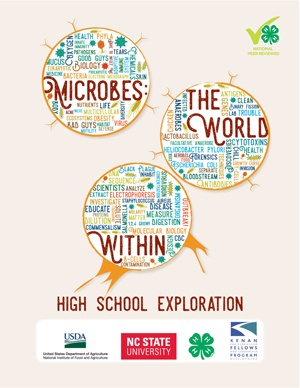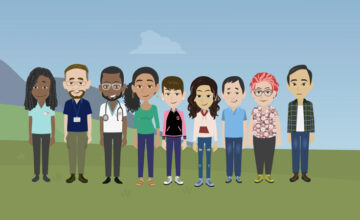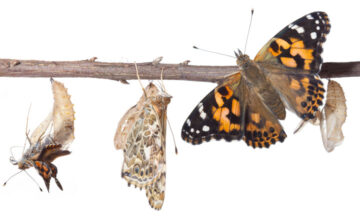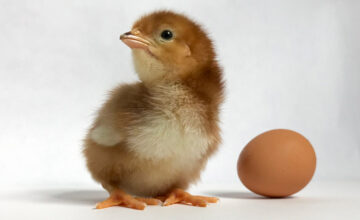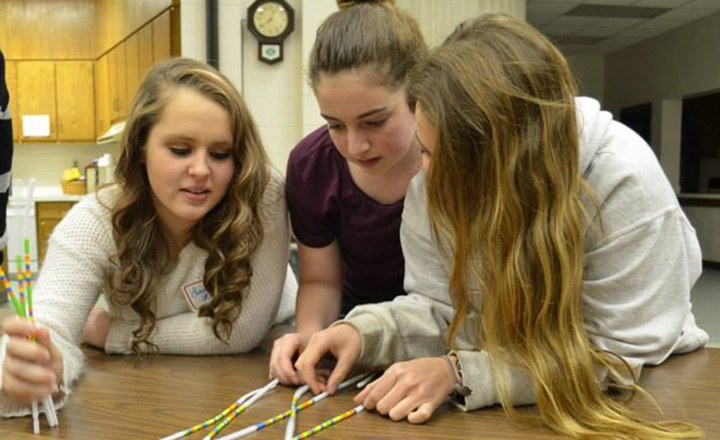
Introduction “Microbes: The World Within – High School Exploration”
The unseen world of bacteria, the microscopic kingdom of life, has an enormous impact on our everyday lives. This series of lessons and activities seek to provide participants with an interactive look at the microbial world from a variety of approaches.
First, participants are introduced to the amazing breadth of this group as they become familiar with the distinguishing characteristics of some representative bacteria that are commonly found in association with humans. Then participants are introduced to the increasingly important concept of the microbiome – the populations of bacteria that inhabit all of our bodies and that contribute to health as well as disease.
Next, learners investigate the mechanisms by which the human body keeps any harmful invaders at bay, both by external protective means as well as through cellular armies that attack pathogens.
The importance of public health organizations and surveillance is demonstrated as learners discover how infectious diseases are tracked and how epidemiologists function to control outbreaks.
Participants then step into the operational world by modeling several tools currently available to scientists for identifying bacteria at the molecular level. Participants model gel electrophoresis of DNA molecules as well as DNA sequencing strategies that are on the cutting edge of research.
Environmental factors that can affect the growth of bacterial populations are explored in the next lesson. These tiny organisms reproduce very quickly, which can give them an edge when it comes to growing large populations very fast.
Finally, participants can practice several essential lab techniques that are mainstays for anyone seeking to work in a research or lab environment. These hands-on skills are highly desirable in today’s technical workplace. Careers in microbiology can become more appealing through participation in the curriculum.
Age range: 13-18
Grade level: 9-12/High School
Lesson 1: Do These Germs Make Me Look Fat?
Next Generation Science Standards
- NGSS HS-LS 2-6 Evaluate the claims, evidence, and reasoning that the complex interactions in ecosystems maintain relatively consistent numbers and types of organisms in stable conditions, but changing conditions may result in a new ecosystem.
Common Core State Standards in English/Language Arts
- CCSS.ELA-Literacy.RST.9-10.2 Determine the central ideas or conclusions of a text; trace the text’s explanation or depiction of a complex process, phenomenon, or concept; provide an accurate summary of the text.
Youth make Fortune Tellers and use a dichotomous key to test their existing knowledge of the microbial world.
Lesson 2A: Dare to Infect Me!
Next Generation Science Standards
- HS-LS1-2, HS-LS1-4 Models (e.g., physical, mathematical, computer models) can be used to simulate systems and interactions—including energy, matter, and information flow—within and between systems at different scales.
- HS-LS1-3 Stability and Change: Feedback (negative or positive) can stabilize or destabilize a system.
- HS-LS2-8 Empirical evidence is required to differentiate between cause and correlation and make claims about specific causes and effects.
Youth observe the progression of spoilage among different bananas to model the innate immune system.
Lesson 2B: Code Red!
Next Generation Science Standards
- HS-LS1-2, HS-LS1-4 Models (e.g., physical, mathematical, computer models) can be used to simulate systems and interactions—including energy, matter, and information flow—within and between systems at different scales.
- HS-LS1-3 Stability and Change: Feedback (negative or positive) can stabilize or destabilize a system.
- HS-LS2-8 Empirical evidence is required to differentiate between cause and correlation and make claims about specific causes and effects.
Youth create physical models of the adaptive immune system and use those models to simulate an immune response.
Lesson 3: Microbes in Our Food
North Carolina Essential Standards in Science
- Bio.2.1.4 Explain how a disease can disrupt ecosystem balance. (Examples: AIDS, influenza, tuberculosis, Dutch elm disease, Pfiesteria, etc.)
- Bio.2.2.1 Infer how human activities (including population growth, pollution, global warming, burning of fossil fuels, habitat destruction, and introduction of nonnative species) may impact the environment.
- Bio.3.4.3 Explain how various disease agents (bacteria, viruses, chemicals) can influence natural selection.
Next Generation Science Standards
- HS-LS1-3 Plan and conduct an investigation individually and collaboratively to produce data to serve as the basis for evidence, and in the design: decide on types, how much, and accuracy of data needed to produce reliable measurements and consider limitations on the precision of the data (e.g., number of trials, cost, risk, time), and refine the design accordingly.
- HS-LS1-3 Scientific inquiry is characterized by a common set of values that include: logical thinking, precision, open-mindedness, objectivity, skepticism, replicability of results, and honest and ethical reporting of findings.
- HS-LS2-2, HS-LS2 A complex set of interactions within an ecosystem can keep its numbers and types of organisms relatively constant over long periods of time under stable conditions. If a modest biological or physical disturbance to an ecosystem occurs, it may return to its more or less original status (i.e., the ecosystem is resilient), as opposed to becoming a very different ecosystem. Extreme fluctuations in conditions or the size of any population, however, can challenge the functioning of the ecosystems in terms of resources and habitat availability.
Youth investigate infectious disease outbreaks using data from the CDC website.
Lesson 4: Knock, Knock – Who’s There?
Next Generation Science Standards
- NGSS HS-LS3.A –Each chromosome consists of a single very long DNA molecule, and each gene on the chromosome is a particular segment of that DNA. The instructions for forming species’ characteristics are carried in DNA. All cells in an organism have the same genetic content, but the genes used (expressed) by the cell may be involved in regulatory or structural functions, and some have no as-yet known function
- NGSS HS-LS4.A –Genetic information provides evidence of evolution. DNA sequences vary among species, but there are many overlaps; in fact, the ongoing branching that produces multiple lines of descent can be inferred by comparing the DNA sequences of different organisms. Such information is also derivable from the similarities and differences in amino acid sequences and from anatomical and embryological evidence.
Youth explore how modern biotechnology uses DNA to identify pathogens.
Lesson 5: 1, 2, 4, Grow
Next Generation Science Standards
- HS-LS2-2. Use mathematical representations to support and revise explanations based on evidence about factors affecting biodiversity and populations in ecosystems of different scales.
- HS-ETS1-3. Evaluate a solution to a complex real-world problem based on prioritized criteria and trade-offs that account for a range of constraints, including cost, safety, reliability, and aesthetics, as well as possible social, cultural, and environmental impacts.
Common Core State Standards in Mathematics
- CCSS.Math.Content.HSS-IC.A.1 Understand statistics as a process for making inferences about population parameters based on a random sample from that population.
Youth model bacteria growth and spread under different conditions.
Lesson 6: Double, Double, Toil and Trouble
Next Generation Science Standards
- HS-LS2-1. Use mathematical and/or computational representations to support explanations of factors that affect the carrying capacity of ecosystems at different scales.
Common Core State Standards in Mathematics
- CCSS.Math.Content.HSA-CED.A.2 Create equations in two or more variables to represent relationships between quantities; graph equations on coordinate axes with labels and scales. CCSS.Math.Content.HSA-CED.A.4 Rearrange formulas to highlight a quantity of interest, using the same reasoning as in solving equations. For example, rearrange Ohm’s law V = IR to highlight resistance R.
Youth perform serial dilutions and model cell counting.

